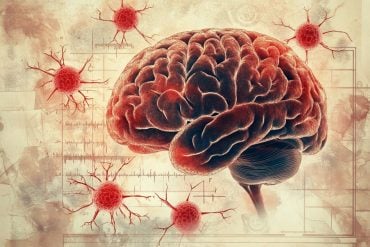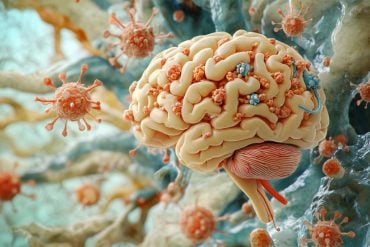Summary: Flavored e-cigarette tobacco engages the taste system, while non-flavored vaped nicotine triggers the brain’s reward system in a similar way observed when people smoke traditional cigarettes.
Source: Penn State
Flavoring can change how the brain responds to e-cigarette aerosols that contain nicotine, according to Penn State College of Medicine researchers. Andrea Hobkirk and her team used functional magnetic resonance imaging (MRI) to understand how the brain’s reward areas react to e-cigarette aerosol with and without flavor.
“There are nearly 12 million e-cigarette users in the United States,” Hobkirk, an assistant professor of psychiatry and behavioral health at Penn State College of Medicine, said.
“The vast majority use e-cigarettes with menthol, mint, fruity and dessert-type flavors. Although regulations that limit the sale of flavored e-cigarettes may help curb use among youth, they might also stop adults from using e-cigarettes as a smoking reduction or cessation aid. We are trying to understand how flavor influences e-cigarette reward and satisfaction for smokers and the risk of nicotine addiction for non-smokers.”
The team first developed a device to deliver e-cigarette aerosols during brain scanning. Next, the research team used this new device to deliver aerosols containing a low dose of nicotine to nine adult female smokers during a single laboratory visit.
One aerosol had a strawberry-vanilla flavor, and the other aerosol was flavorless. The team compared the strength of brain activation and reward brain region involvement between flavored and unflavored aerosols.
“For our study, we were interested in looking first at, for smokers, how flavor might affect their response to nicotine e-cigarettes,” Hobkirk said. “We recruited smokers who had never used e-cigarettes before or were not regular e-cigarette users. What we were interested in is figuring out whether or not flavor changed how they perceived or how their brain responded to this e-cigarette use.”
The researchers found that the strawberry-vanilla aerosol engaged the brain’s taste region. In contrast, the unflavored aerosol engaged the brain’s reward region, similar to observations during cigarette smoking. The researchers published their results in the journal Experimental and Clinical Psychopharmacology.
The researchers also assessed patterns of neural activity between brain regions. Stronger connectivity between two brain regions typically means that these regions are working together. They found that key brain reward regions were strongly connected with flavored aerosol and not unflavored.

The findings suggest that, for smokers, unflavored e-cigarettes may mimic the typical smoking experience more than flavored e-cigarettes.
“We found that for smokers who had never really used e-cigarettes before, the flavor did not make the experience more rewarding for them, at least in terms of what we saw in the brain,” Hobkirk said.
“It did not make the experience of breathing in these aerosols more like a smoking experience. Typically, that’s what smokers are looking for when they’re trying to transition over to a healthier product. They want something that gives all the similar rewarding and sensory-motor effects of their regular combustible cigarette, but without all the harmful effects that come in the toxins of a cigarette.
“We found that adding flavor doesn’t necessarily do that for these smokers, at least what we saw in their response to them in the brain. This could suggest that, potentially, smokers do not necessarily need these flavors to make the transition from a combustible cigarette to an e-cigarette.”
This project is a pilot study. A more extensive study or clinical trial is needed to explore these findings further. Hobkirk’s team will next isolate the independent effects of different flavored e-cigarette aerosols with and without nicotine for smokers and non-smokers.
Funding: Hobkirk is a former Penn State Clinical and Translational Science Institute Early-Stage Investigator Training Program(KL2) scholar and a current career development awardee from the National Institute on Drug Abuse (grant K23 DA045081). She is also a member of Penn State Cancer Institute. Penn State Clinical and Translational Science Institute’s Bridges to Translation Pilot Grant Program funded this project (grant UL1 TR002014).
Other researchers on the team are Kenneth Houser, Brianna Hoglen, and Dahlia Mukherjee, Department of Psychiatry and Behavioral Health; Jonathan Foulds, Department of Psychiatry and Behavioral Health and Department of Public Health Sciences; Zachary Bitzer, Candace Bordner, Jessica Yingst and Reema Goel, all of Department of Public Health Sciences; Alan Fendrich, Jianli Wang and Prasanna Karunanayaka, all of Department of Radiology; John Richie, Department of Public Health Sciences and Department of Pharmacology; and Qing Yang, Department of Neurosurgery, all of Penn State College of Medicine; and Ryan Elias, Department of Food Science, Penn State College of Agricultural Sciences.
About this nicotine and neuroscience research news
Source: Penn State
Contact: A’ndrea Elyse Messer – Penn State
Image: The image is in the public domain
Original Research: Closed access.
“Evidence from an fMRI study that dessert-flavored e-cigarettes engage taste-related, but not smoking-related, brain circuitry for female daily smokers” by Andrea Hobkirk et al. Experimental and Clinical Psychopharmacology
Abstract
Evidence from an fMRI study that dessert-flavored e-cigarettes engage taste-related, but not smoking-related, brain circuitry for female daily smokers
Regulations limiting the sale of flavored e-cigarette products are controversial for their potential to interfere with e-cigarette use as a cessation aid in addition to curbing youth use. Limited research suggests that flavor might enhance the addictive potential of e-cigarettes; however, the acute effects of flavored aerosols on brain function among humans have not been assessed.
The present study aimed to isolate and compare the neural substrates of flavored and unflavored e-cigarette aerosols on brain function among nine female daily smokers.
Participants inhaled aerosolized e-liquid with 36 mg/mL of nicotine with and without a strawberry–vanilla flavor while undergoing functional magnetic resonance imaging. We used general linear modeling to compare whole-brain mean neural activation and seed-to-voxel task-based functional connectivity between the flavored and unflavored inhalation runs.
Contrary to our hypothesis, the flavored aerosol was associated with weaker activation than the unflavored aerosol in the brain stem and bilateral parietal-temporal-occipital region of the cortex. Instead, the flavor engaged taste-related brain regions while suppressing activation of the neural circuits typically engaged during smoking and nicotine administration. Alternatively, functional connectivity between subcortical dopaminergic brain seeds and cortical brain regions involved in motivation and reward salience were stronger during the flavored compared to unflavored aerosol run.
The findings suggest that fruity and dessert-flavored e-cigarettes may dampen the reward experience of aerosol inhalation for smokers who initiate e-cigarette use by inhibiting activation of dopaminergic brain circuits.
These preliminary findings may have implications for understanding how regulations on flavored e-cigarettes might impact their use as cessation aids.






